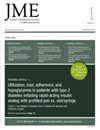Treatment patterns, healthcare resource utilization, and costs in Medicare patients with diffuse large B-cell lymphoma: A retrospective claims analysis (2015-2020).
IF 2.9
4区 医学
Q2 HEALTH CARE SCIENCES & SERVICES
引用次数: 0
Abstract
AIMS To understand treatment patterns, healthcare resource utilization (HCRU), and economic burden of diffuse large B-cell lymphoma (DLBCL) in elderly adults in the US. MATERIALS AND METHODS This retrospective database analysis utilized US Centers for Medicare and Medicaid Services Medicare fee-for-service administrative claims data from 2015 to 2020 to describe DLBCL patient characteristics, treatment patterns, HCRU, and costs among patients aged ≥66 years. Patients were indexed at DLBCL diagnosis and required to have continuous enrollment from 12 months pre-index until 3 months post-index. HCRU and costs (USD 2022) are reported as per-patient per-month (PPPM) estimates. RESULTS A total of 11,893 patients received ≥1-line (L) therapy; 1633 and 391 received ≥2L and ≥3L therapy, respectively. Median (Q1, Q3) age at 1L, 2L, and 3L initiation, respectively, was 76 (71, 81), 77 (72, 82), and 77 (72, 82) years. The most common therapy was R-CHOP (70.9%) for 1L and bendamustine ± rituximab for 2L (18.7%) and 3L (17.4%). CAR T was used by 14.8% of patients in 3L. Overall, 39.6% (1L), 42.1% (2L), and 47.8% (3L) of patients had all-cause hospitalizations. All-cause mean (median [Q1-Q3]) costs PPPM during each line were $22,060 ($20,121 [$16,676-$24,597]) in 1L, $30,027 ($20,868 [$13,416-$31,016]) in 2L, and $47,064 ($25,689 [$15,555-$44,149]) in 3L, with increasing costs driven primarily by inpatient expenses. Total all-cause 3L mean (median [Q1-Q3]) costs PPPM for patients with and without CAR T were $153,847 ($100,768 [$26,534-$253,630]) and $28,466 ($23,696 [$15,466-$39,107]), respectively. CONCLUSIONS No clear standard of care exists in 3L therapy for older adults with relapsed/refractory DLBCL. The economic burden of DLBCL intensifies with each progressing line of therapy, thus underscoring the need for additional therapeutic options.弥漫大 B 细胞淋巴瘤医保患者的治疗模式、医疗资源利用率和费用:回顾性索赔分析(2015-2020 年)。
材料和方法:这项回顾性数据库分析利用美国医疗保险和医疗补助服务中心(US Centers for Medicare and Medicaid Services)2015 年至 2020 年的医疗保险付费服务行政报销数据,描述了年龄≥66 岁的 DLBCL 患者的特征、治疗模式、HCRU 和费用。患者在确诊为 DLBCL 时被纳入索引,并要求从索引前 12 个月到索引后 3 个月连续注册。结果共有11893名患者接受了≥1线(L)治疗;分别有1633名和391名患者接受了≥2L和≥3L治疗。开始接受 1L、2L 和 3L 治疗时的中位(Q1,Q3)年龄分别为 76(71,81)岁、77(72,82)岁和 77(72,82)岁。最常见的疗法是:1L 采用 R-CHOP(70.9%),2L(18.7%)和 3L(17.4%)采用苯达莫司汀±利妥昔单抗。3L患者中有14.8%使用了CAR T。总体而言,39.6%(1L)、42.1%(2L)和47.8%(3L)的患者全因住院。各线路的全因平均费用(中位数[Q1-Q3])PPPM 在 1L 为 22,060 美元(20,121 美元[16,676-24,597 美元]),在 2L 为 30,027 美元(20,868 美元[13,416-31,016 美元]),在 3L 为 47,064 美元(25,689 美元[15,555-44,149 美元]),费用增加的主要原因是住院费用。使用和未使用CAR T的患者3L全因平均(中位数[Q1-Q3])总费用PPPM分别为153,847美元(100,768美元[26,534-253,630美元])和28,466美元(23,696美元[15,466-39,107美元])。DLBCL的经济负担随着治疗方案的进展而加重,因此需要更多的治疗方案。
本文章由计算机程序翻译,如有差异,请以英文原文为准。
求助全文
约1分钟内获得全文
求助全文
来源期刊

Journal of Medical Economics
HEALTH CARE SCIENCES & SERVICES-MEDICINE, GENERAL & INTERNAL
CiteScore
4.50
自引率
4.20%
发文量
122
期刊介绍:
Journal of Medical Economics'' mission is to provide ethical, unbiased and rapid publication of quality content that is validated by rigorous peer review. The aim of Journal of Medical Economics is to serve the information needs of the pharmacoeconomics and healthcare research community, to help translate research advances into patient care and be a leader in transparency/disclosure by facilitating a collaborative and honest approach to publication.
Journal of Medical Economics publishes high-quality economic assessments of novel therapeutic and device interventions for an international audience
 求助内容:
求助内容: 应助结果提醒方式:
应助结果提醒方式:


